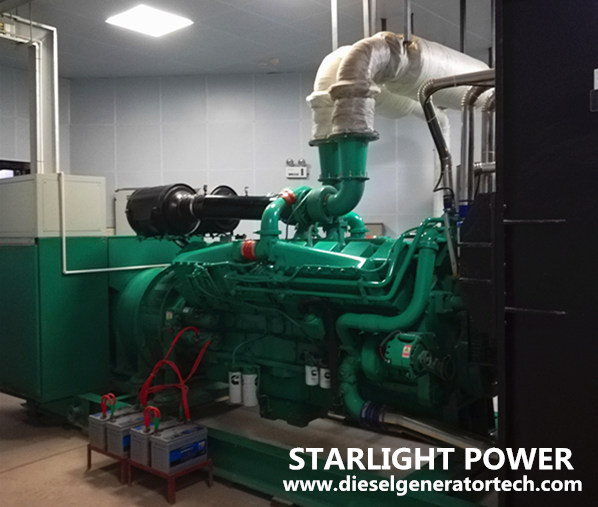When using a generator, it is inevitable to encounter various problems. What are the common problems? How to solve it? Starlight will list some common generator failure problems and solutions.
1. The generator does not operate according to the specified technical conditions. For example, if the stator voltage is too high, the iron loss increases; if the load current is too large, the stator winding copper loss increases.
If the frequency is too low, the cooling fan speed will be slowed down, which will affect the heat dissipation of the generator. If the power factor is too low, the rotor excitation current will increase and the rotor will heat up. Check that the indication of the monitoring instrument is normal. If it is abnormal, necessary adjustment and treatment shall be carried out to make the generator run in accordance with the specified technical conditions.
2. The three-phase load current of the generator is unbalanced, and the overloaded one-phase winding will overheat; if the difference between the three-phase current exceeds 10% of the rated current, it is a serious phase current imbalance, and the three-phase current imbalance will generate a negative sequence magnetic field , increasing the loss, causing magnetic pole winding and ferrule and other components to heat up. The three-phase load should be adjusted to keep the current of each phase as balanced as possible.
3. The air duct is blocked by dust accumulation, resulting in poor ventilation, which makes it difficult for the generator to dissipate heat. The dust and oil dirt on the air duct should be removed to make the air duct unobstructed.
4. If the air inlet temperature is too high or the water inlet temperature is too high, the cooler may be blocked. Reduce the air or water inlet temperature to clear the blockage in the cooler. Before the fault is eliminated, the generator load should be limited to reduce the generator temperature.
5. Too much or too little grease is added to the bearing. it should be added according to the regulations, usually 1/2 to 1/3 of the bearing chamber (the upper limit for low speed and the lower limit for high speed), and not more than 70% of the bearing chamber is appropriate.

6. The bearing is worn. If the wear is not serious, the bearing will overheat locally; if the wear is severe, the stator and rotor may be rubbed, causing the stator and rotor wall to overheat. The bearing should be checked for noise. If friction between the stator and rotor is found, stop the machine immediately for maintenance or replace the bearing.
7. The insulation of the stator core is damaged, causing a short circuit between the pieces, which causes local eddy current loss of the core to increase and generate heat, and in severe cases, the stator windings are damaged. Stop the machine immediately for maintenance.
8. The parallel wires of the stator winding are broken, causing the current of other wires to increase and heat up. Stop the generator immediately for maintenance.
Generator neutral line has abnormal voltage to the ground
1. Under normal circumstances, very low voltage appear due to the influence of high harmonics or manufacturing process, the air gap and magnetic potential is uneven. If the voltage is between one and several volts, there is no danger, do not need to deal with .
2. The generator winding has a short circuit or poor insulation to the ground, which causes the performance of the electrical equipment and generator to deteriorate, and it is easy to heat up. It should be repaired in time to avoid the expansion of the accident.
3. The neutral line has no voltage to ground when no load, and the voltage appears when there is a load, which is caused by three-phase imbalance. The three-phase load should be adjusted to make it basically balanced.
Excessive generator current
1. The load is too large, and the load should be reduced.
2. If a short circuit or ground fault occurs on the power transmission line, the line should be repaired and returned to normal after troubleshooting.
Generator terminal voltage is too high
1. The grid voltage of the generator parallel to the grid is too high. The voltage of the parallel generator should be reduced.
2. The overexcitation caused by the failure of the excitation device, the excitation device should be repaired in time.
Generator loses remanence and cannot generate power when starting
1. Residual magnetism is often lost after shutdown because the material used for the exciter magnetic pole is close to soft steel, and the remanence is less. When there is no current in the excitation winding after shutdown, the magnetic field disappears. A storage battery should be prepared and magnetized before generating electricity.
2. The magnetic pole of the generator loses its magnetism, and the DC current larger than the rated current (with a very short time) should be passed through the winding for magnetization, that is, sufficient residual magnetism can be restored.
Excitation reactor temperature of automatic excitation device is too high
1. The reactor coil is locally shorted, and the reactor should be repaired.
2. The air gap of the magnetic circuit of the reactor is too large. The air gap of the magnetic circuit should be adjusted.
After the generator starts, the voltage cannot rise
1. The excitation circuit is disconnected and the voltage cannot rise. Check whether the excitation circuit is disconnected and whether the contact is good.
2. The residual magnetism disappears. If there is no indication from the exciter voltmeter, it indicates that the remanence disappears. The exciter should be magnetized.
3. The polarity of the magnetic field coil of the exciter is reversed, and its positive and negative connecting wires should be switched.
4. When doing some tests during generator maintenance, the magnetic field coil is mistakenly passed with reverse direct current, which causes the residual magnetism to disappear or reverse, and the magnetization should be performed again.
Comments
Post a Comment